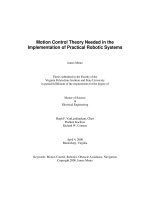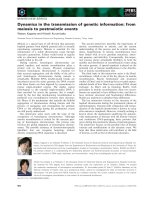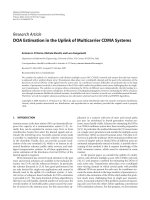Open source softwares in building WebGIS of bus information system
Bạn đang xem bản rút gọn của tài liệu. Xem và tải ngay bản đầy đủ của tài liệu tại đây (548.35 KB, 6 trang )
International Symposium on Geoinformatics for Spatial Infrastructure Development in Earth and Allied Sciences 2012
OPEN SOURCE SOFTWARES IN BUILDING WEBGIS OF BUS
INFORMATION SYSTEM.
Duc Nguyen Huu
1
and Chon Le Trung
2
1
University of Resources and Environment, Ho Chi Minh City.
Email:
2
University of Technology, Ho Chi Minh City
Email:
ABSTRACT
Easily and visually accessing to buses information is the important factors to growing up voluntary
using-public-transportation guests, especially in over-10-milions-residents city as Ho Chi Minh City. More and
more, with a WebGIS, the information will be more accessible. That is due to its representation, including
images, routes, related spatial sites… This paper focuses on using low cost open source software solution (the
software included: pgRouting, GeoServer, OpenLayer,…), to demonstrate some activity in bus system.
1. INTRODUCTION
Currently the buses are one of the means of public transportation, which was heavily
invested to reduce the amount of personal vehicles, thereby reducing traffic congestion in major
cities.
In addition to the investment in facilities such as vehicles, terminal… the system
management and providing information to users are critical to the bus system to reach more
customers.
If they are supplied with sufficient information, they will easily select and decide on the bus line
appropriate with the route.
Ho Chi Minh city currently has more than 3000 buses on 129 routes operated differently,
with more than 15000 vehicle trips per day, approximately about 7% demand of travel, oriented
development in 2020 of the city bus to meet the demand for travel 15-20% of the people, so that
the route of vehicles and cars will grow in the future.
The system management and providing information for the bus with such a big amount of
data require a scientific solution. Information that users want to know exactly the right onto
railroad, down at the station, how long it takes and how much it costs… and so on. Therefore the
construction of a WebGIS used data about buses, bus routes, terminals and bus location data in
real time using open source software to provide information to users is urgently needed.
Around the world, there are many countries that have built WebGIS information & query
system for passengers such as Singapore with IRIS (Intelligent Route Information System), or in
the city of Kaohsiung (Taiwan) has built ITS systems (Intelligent Information System) which
provide information bus. These systems were brought utilities for passengers to ride.
2. METHODOLOGY:
2.1 Theoretical :
In the information that the user is interested in, the information about the pathfinder in the
system bus is the most complex.
Finding the path itself was very complex with many algorithm, which was developed as
A*, Dijkstra, Shooting* and each algorithm has its advantages as well as disadvantages. Finding
Open source softwares in building WebGIS of bus information system.
the way to the bus has its own characteristics: Routes that the bus moves are the roads but it does
not completely coincide with the road traffic (because the buses do not go on all the roads and
streets). Given that, if the buses are separate from roads and streets, then the search will not be
performed.
Figure 1: The system cannot find the path if the start and destination point not in peak of
bus route, or two route is not connected.
Combination between road and bus, with this way user can locate any 2 coordinates on a map
and the system will answer queries correctly and in details.
Figure 2: System will find the way: walking then go to buses and walk back down
Finding the way to the bus not merely find the shortest path by bus take the road map, in
the process of moving by bus, transit is inevitable, so the weight for the cost of moving will
based on three elements: the shortest path, transit least and walking least.
Cost from the state Tk to the status of Ti is calculated according to the formula recommended as
follows:
cost(Tk, Ti) = KCT(Tk, Ti)*A + B (1)
Where:
KCT (Tk, Ti): The distance actually travelled from to Tk to Ti
A: Coefficient of Road/Bus route
B: Coefficient of transit
System of the bus moves follow the bar itinerary, so the anticipated location of a vehicle
based on the road map and timetable is completely able to perform. However with the status
International Symposium on Geoinformatics for Spatial Infrastructure Development in Earth and Allied Sciences 2012
regularly jammed roads in the city, this would be the lack of accurate predictions, so the
acquisition of bus information in real time is needed.
Providing information to passengers travelling by bus in data such as cruise lines, time schedule
or information about the station, the line through the station is fairly easy, maybe even using
common web technologies and database without spacial such as MySQL, Acess…
However, if you need advanced information such as position or queries to find the
optimal way for the bus, the database must be able to store spacial data, and web can display and
interact with the map. So WebGIS solution is suitable for problems, to build many WebGIS
technology to choose from, you can use the commercial software such as ArcGIS, ArcIMS,
Oracle Spatial Sever… or chooses open source software like GeoServer, MapServer, OpenLayer,
PostgreSQL…
In this study, open source software is used with the advantages such as free of cost,
custom computer systems and computer technology activeness.
2.2 Practical steps:
Step 1: Data collection.
The data here include background data including system administration, data about road
traffic. Data about systems, terminals, and routes was provided from the Central Operator of
Public Passenger Transport, in addition data about terminals, routes also collect by GPS, location
of vehicles in real time was collected by black boxes that integrates GPS and send data through
GPRS or 3G connection of telecommunication networks.
Figure 3: Transmission of GPS data displayed on the dedicated LiveGPSvn software with
map background is Google Maps
The GPS receiver has a 10-15 m degree of accuracy, however this totally meets the relative
positions of the car in real time.
When GPS signal is lost or GPRS signal is lost, we can determine the location of the bus through
the schedule and position, speed previously received from bus.
Step 2: Data processing
For service queries the data traffic in the city need to cut at the intersection.
Open source softwares in building WebGIS of bus information system.
Figure 4: The roads are cut at the intersection
The data are aggregated in database PostgreSQL/PostGIS, in addition to serving for the
queries with PgRouting library, you will need to build the columns properties such as source,
target, length and create network topology for the network traffic through the SQL function in
PostgreSQL, including attention to calculating weighted length for edges to look towards the cost
of the walk and the bus ride.
Step 3: Build WebGIS Applications
After collection and processing of data is carried out construction of WebGIS system buses
Ho Chi Minh City by connecting a database just created with GeoServer and Openlayer library
to display interactive maps.
Simple queries such as station information, bus route information can be done directly
through the Geoserver, however with the queries as complex as finding the optimum paths,
search for near the station, seeking to use the function of language PHP queries directly on the
database and via PostgreSQL, PgRouting, PostGIS to recheck query results and through
Openlayer to display.
3. RESULTS:
Structure of WebGIS system:
International Symposium on Geoinformatics for Spatial Infrastructure Development in Earth and Allied Sciences 2012
Figure 5: Structure of WebGIS system for search query service bus.
WebGIS research products and installed on the system of open-source software:
Database management systems: PostgresSQL 8.4 + PostGIS 1.5 in conjunction with PgRouting
1.05 library for handling queries route data format.
Technological process and view the map: Apache Tomcat 6.0 + GeoServer 2.0 for server,
javascript library for displaying maps: Openlayer 2.11 and language PHP for database queries.
WebGIS with experimental data sample:
Open source softwares in building WebGIS of bus information system.
Figure 6: WebGIS interfaces.
4. CONCLUSTION AND DISCUSSION:
From the results of research on the construction of WebGIS, some conclusions are drawn as
follows:
The construction of full and accurate data for the management system of bus is a key
decision for the provision of information to users.
The open source software to build WebGIS in the system allows us to customize the
advanced and master technology in the process of operation, in addition to the cost savings from
using open source software.
How to access to information of users is very important, so there needs to be additional
external WebGIS solutions to provide online information, schedule …through common protocols
such as access from mobile through WAP (Wireless Application Protocol), SMS, or Mobile GIS.
REFERENCES
[1] Daniel Kastl, Claude Philipona, Frédéric Junod, Anton Patrushev , 2009. Workshop- FOSS4G Routing
with pgRouting tools and OpenStreetMap road data, FOSS4G 2009- OSaKa, Japan.
[2] Hassan A.Karimi, Ratchata Peachavanish , 2004. Finding Optimal Bus Service Routes: internet-Based
Methodology to Serve Transit Patrons, Journal of Computing in Civil Engineering, Vol 18, issue 2, 2004,
9 pages.









